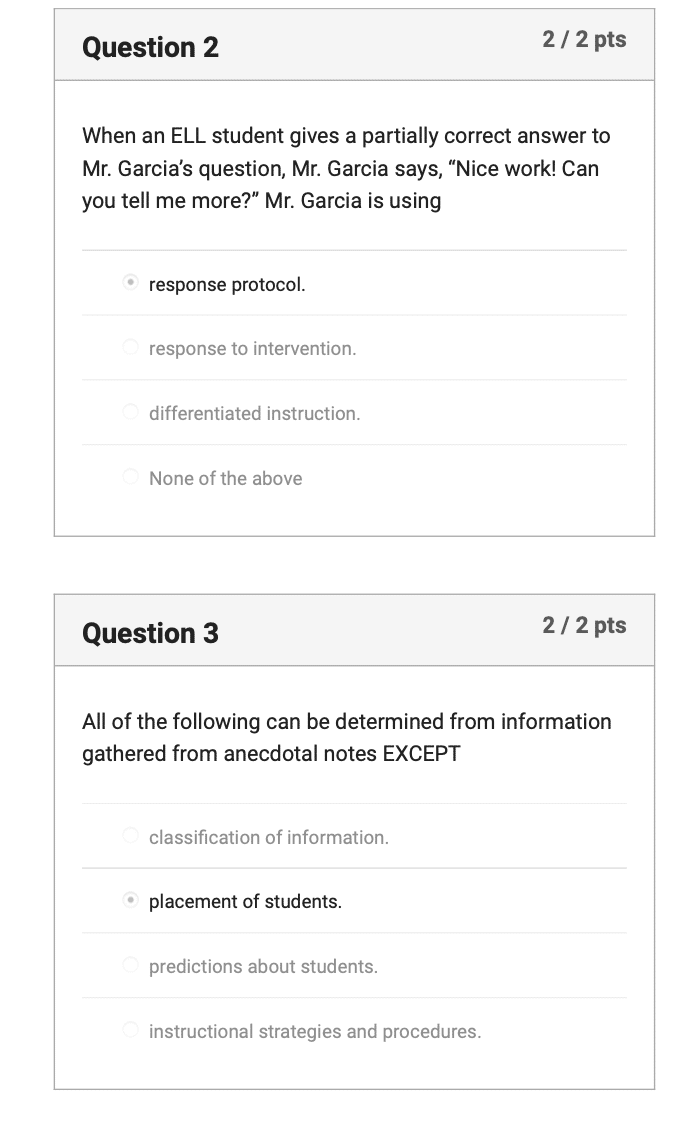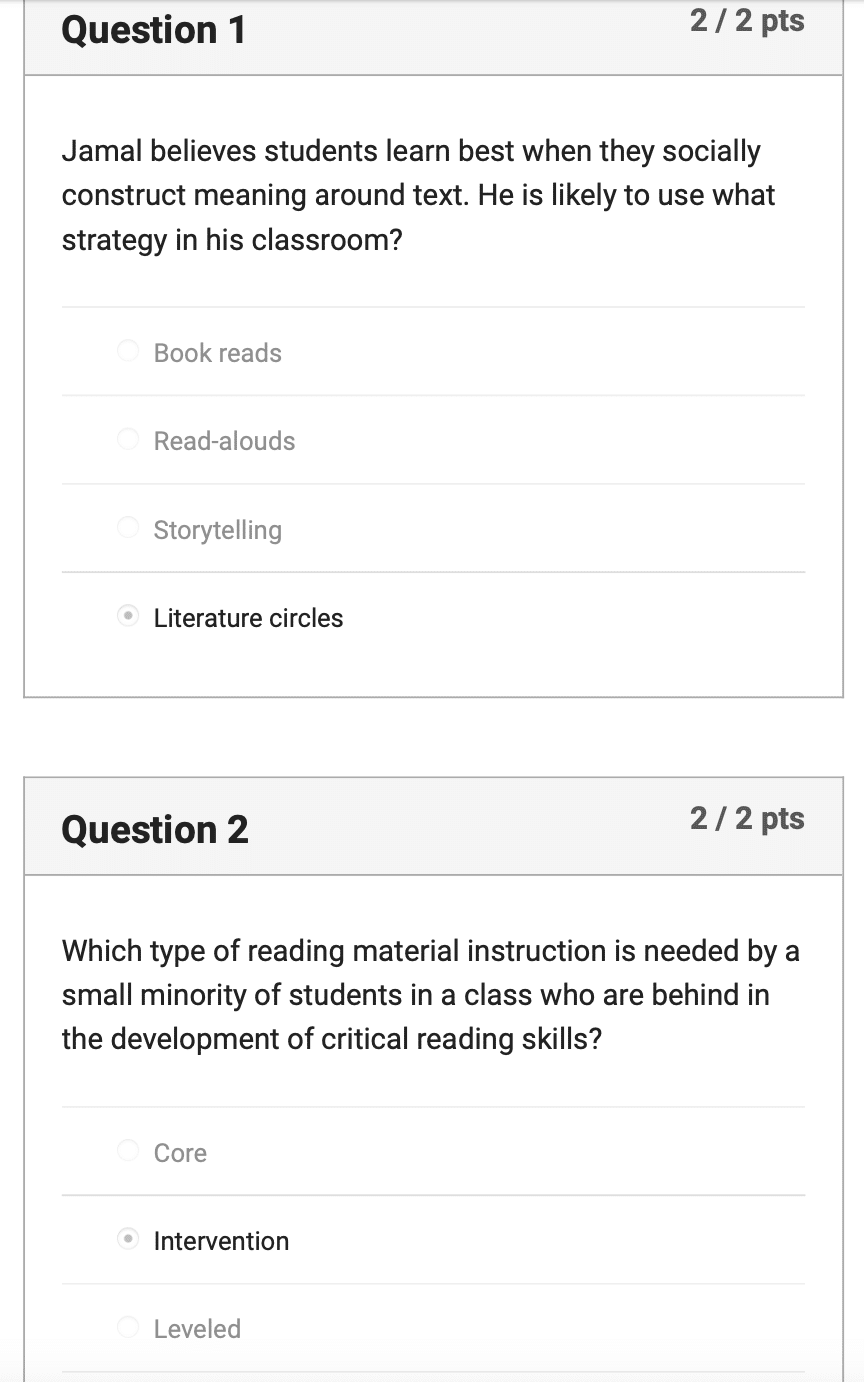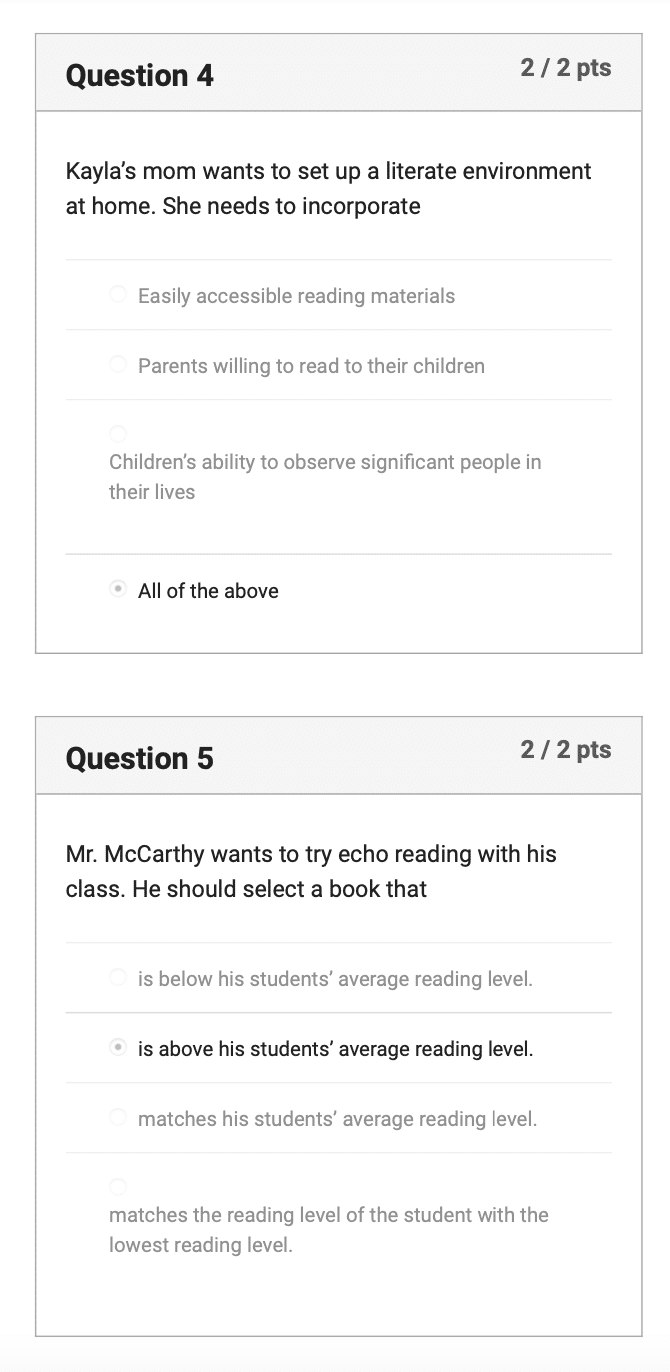EDUC 318 Literacy Quizzes Quiz
EDUC 318 Quiz Literacy – Knowledge and Beliefs
Covers the Textbook material from Module 1: Week 1 — Module 3: Week 3.
- A reading professional continually needs to study the knowledge base from a ________ perspective.
- When an ELL student gives a partially correct answer to Mr. Garcia’s question, Mr. Garcia says, “Nice work! Can you tell me more?” Mr. Garcia is using
- All of the following can be determined from information gathered from anecdotal notes EXCEPT
- Piaget, one of the preeminent child psychologists of the twentieth century, theorized that children don’t internalize knowledge from the outside but construct it from within their heads. This theory is known as
- Which of the following is NOT a suggested way for teachers to support the first language of ELLs?
- Vygotsky’s theory of cognitive development is similar to Piaget’s theory in that it as the alphabetic principle.
- Goldstein knows extensive reading is critical to the development of reading proficiency and practice provides the opportunity for students to combine the skills and strategies that teachers work to develop. With this in mind she knows children should be reading
- The _________ approach focuses on projects that are culturally driven.
- Which approach has been useful for meeting the needs of English language learners because it embraces the natural language of children and provides opportunities for meaningful text for students from diverse backgrounds?
- Inclusion means that
- English language learners best learn academic language when it is taught via
- The reliability of standardized test is
- Berg has his students involved in self-assessments, which are
- Which of the following is NOT a characteristic of standardized tests?
- Which of the following is the best illustration of metacognition?
- Which of the following is NOT based on the top-down principles?
- Through ________ you can discover what children are thinking and feeling and how they feel about language learning.
- When taking a child’s running record, the kinds of self- corrections the child makes
- Briggs is very concerned about identifying a book that is at the instructional level for Latisha to read independently. This means Latisha should be able to read this book with what percentage of unknown words?
- Which of the following are often left out of standardized testing?
- Which of the following are used in technology-based instruction?
- Which of the following is NOT a major category of the Sheltered Instruction Observation Protocol (SIOP)?
- Based on current research, the International Reading Association recommends that reading instruction for students who speak languages other than English
- Which of the following approaches to teaching reading best compliments the Common Core State Standards because reading, writing, listening, and speaking apply across content areas and are intended to help students read and write well in all disciplines?
- Which of the following statements is true regarding approaches to reading instruction and struggling readers?

EDUC 318 Quiz Literacy – Components of Literacy
Covers the Textbook material from Module 4: Week 4 — Module 5: Week Grades 5.
- You are a second-grade teacher with a student whose second language is English. Which activity should you do to give this student more confidence in the classroom and increase her fluency skills?
- Direct instruction and student practice are essential for the
- Which of the following vocabulary strategies might be used to increase Kaitlyn’s students’ in-depth vocabulary knowledge while reading their social studies text?
- Kayla’s mom wants to set up a literate environment at home. She needs to incorporate
- McCarthy wants to try echo reading with his class. He should select a book that
- Which of the following is NOT one of the best predictors of later success in literacy achievement as confirmed by the Early National Literacy Panel?
- Which of the following is least likely to be in a literate environment?
- Which of the following is NOT one of the basic cognitive operations?
- involves teaching children how to identify words through prefixes, suffixes, and root words.
- The word “dict” is a(n) __ for “ dictation.”
- Jackson wants to assess accuracy and automaticity so she uses
- Which basic cognitive operation is usually NOT associated with concept circles?
- When a child reads the word “money” for “monkey,” the student is in which developmental phase for word identification?
- While reading a big book to his preschool class Mr. Raymond holds the book so the children can see the words and pictures while his finger follows the line of print. This activity would contribute to the children’s reading development primarily by
- To access alphabet knowledge a teacher must
- Students in an eighth-grade class are studying the Civil War in social studies. As part of this unit of study, they work together to create a semantic map of words associated with the Civil War, including words that they have recently learned (e.g., emancipation, habeas corpus). This activity is most likely to promote students’ vocabulary development by
- Martinez is generating a vocabulary list for his students to learn. The list should include
- is a vocabulary-development strategy in which students must generate one sentence that correctly demonstrates an understanding of a group of words and their relationship to each other.
- During writing time at preschool Xander drew a stick figure and made some unintelligible scribbles around it. When he showed it to his teacher, he pointed to the scribbles and says, “This says ‘I love mommy.'” This behavior suggests Xander most likely
- In his kindergarten class Mr. Gulliver wants to work on fluency and needs to know the best strategy for children this age. You tell him that he should use
- Which of the following is a strategy for teaching structural analysis?
- Which literacy development phase marks the time when children become curious about print and print- related activities?
- Kate is three and loves to be read to. At preschool, she picks up an unfamiliar book, opens it to the end, points to the text, and begins to “pretend read” the story. These behaviors suggest that Kate most likely
- Beginning readers benefit from developmentally appropriate practices that are home-centered language-centered play-centered
- In Ms. Clark’s second grade class students are timed monthly on reading rate. When asked why she does this, Ms. Clark says studies have shown high correlations between rate and reading. What would you tell Ms. Clark

EDUC 318 Quiz Literacy – Comprehension and Reading and Writing Connections
Covers the Textbook material from Module 6: Week 6 — Module 7: Week 7.
- Jamal believes students learn best when they socially construct meaning around text. He is likely to use what strategy in his classroom?
- Which type of reading material instruction is needed by a small minority of students in a class who are behind in the development of critical reading skills?
- The _____ type of reading materials includes basal readers and trade books.
- Anticipation guides are recommended for:
- The three broad categories of reading materials are core instructional programs, supplemental materials, and
- Which of the following does not make sense to utilize when encouraging students to annotate text?
- Teachers should question themselves when making decisions about textbook difficulty. Which one of the following questions is least important in the decision making process?
- Kristine loves children’s literature and brings in a wide variety for instruction in all of her content classes. She loves to read a narrative related to a topic of study and her students enjoy it, too. However, she has been told to strictly adhere to the Common Core State Standards’ criteria for using text across disciplines. This means she will need to
- Rozlyn believes students should interact with text and share the experience with others by reacting to text. This supports
- Abbey has been using literature journals in her sixth grade classroom for years and likes the freedom it gives her students to communicate their thoughts about what they have read. However, she wants to update her technique. What would you suggest she do?
- Which of the following is a category for types of reading materials described by the text?
- Which of the following steps is NOT necessary for QtA lessons?
- Today’s basals still misunderstand the importance of
- Peabody asked his class to brainstorm everything they know about World War II and then asked them what they wanted to know about World War II prior to reading. What strategy is Mr. Peabody utilizing in his classroom?
- are collections of stories and poems that are usually organized by theme.
- In a community of readers, all of the following are stressed EXCEPT
- Circular story maps
- The term __________ refers to books written for the general public, as opposed to books written specifically for classroom use.
- Which of the following is NOT important to consider when determining what makes a good collection of books?
- programs in basal readers emphasize reading and writing connections, writing activities, listening, and speaking.
- Which of the following is meant to help students become aware of the purposes of a reading assignment?
- The set of technological and communication skills needed to be productive citizens in today’s world is known as:
- help(s) specify parts of a story and how they tie together to form a well-constructed story.
- Textually implicit questions are
- Which of the following is not particularly a benefit of curriculum-based reader’s theater?
